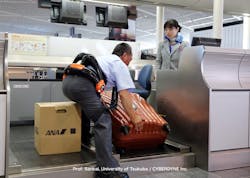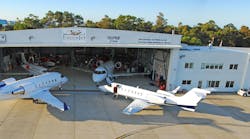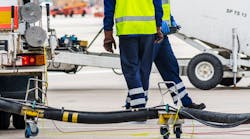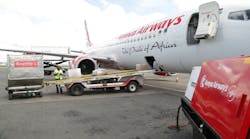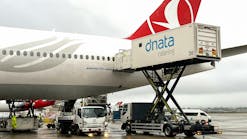How Japan is Using Technology to Support Baggage Handlers
Japan is one of the most technologically advanced countries in the world, as well as a leader in technological solutions that help improve line operatives’ well-being on the ramp, especially when loading bags, thanks to technological innovations developed in Japan that are making their way into the aircraft ground handling environment.
Robotic suits, mounted to employees’ waists, are being used by baggage handlers in Japan to assist with manual labor.
The Hybrid Assistive Limb (HAL) Lumbar Type for Labor Support, developed by CYBERDYNE Inc. of Japan, is a lightweight and compact device that weighs approximately 6½ pounds and provides support to help avoid back strains and other injuries.
“HAL Lumbar Type for Labor Support mitigates risks of the wearer’s back pain when he or she lifts heavy goods, reducing stress applied on the lumbar region by up to 40 percent,” says Prof. Yoshiyuki Sankai, CEO of CYBERDYNE. “This is achieved by reading the bio-electric signals. The device assists a wearer’s movement according to his or her intention and reduces stress applied on the lumbar region. We can increase the assistance ratio, which depends on soft limiter settings, if needed in the future.”
A Solution for an Aging Workforce
Japan is experiencing a ‘super aging’ society, with a trend of population aging coupled with falling birth rates envisaged to accelerate. This indicates a decline in the proportion of people of working age, while life expectancy continues to increase.
“HAL, which enables the wearer’s bodily functions to be supported and enhanced, can contribute to stopping the shrink of Japan’s workforce in some industries, including the aircraft ground handling industry,” says Prof. Sankai. “It seems that, considering possible labor shortages in the near future, ground handling companies would like to protect their existing workforce by mitigating the risk of back pain. This also leads to improvement in the work environment that would attract new workers.”
How it Works
The HAL device is utilized to improve the work environment and to prevent work related injuries. The device works to reduce physical effort by means of specifically developed technology.
“When a wearer intends to move his or her body, various signals are sent from the brain to the muscles through the nervous system, and these signals leak onto the skin surface as bio-electric signals,” explains Prof. Sankai. “HAL detects and analyzes these signals and generates power assist torque with its motor to assists the wearer’s intended movement.
“Frames of HAL lumbar type are fixed to the wearer’s body with moulded fastening equipment of lumbar and thigh. Lumbar mould assumes the role to limit movement of lumbar vertebrae. Power units are directly attached on both hip joints of the HAL to support the hip flexion and extension movement. The actuators' torque is transmitted from the HAL to the wearer’s body through the mould fastening equipment.”
Business Case
It can be expected that innovative solutions, such as the HAL, would require a business case for operations managers to make to the headquarters to justify investing in such type of technologies. Indeed, it might well be the case that sophisticated technologies require a certain amount of investment, which top management might be willing to make only provided that the likes of costs and benefits analysis are performed and possible returns on investment compounded.
“There is currently no extended quantitative investigation that shows potential return on investment on our technologies, but it is reported that this device allows the workers including female and/or aged workers, and workers with back pain, to work for longer hours without fatigue,” says Prof. Sanakai.
“In addition, we do have a report conducted by the Kanagawa Prefecture in Japan which investigated its usage of HAL Lumbar Type for Care Support, which is similar to HAL Lumbar Type Labor Support but uses different algorithms to fit the tasks in care facilities. According to this survey, over 80 percent of the care workers who used HAL noticed the decrease of their fatigue and over 80 percent of the facilities had a reduced turnover rate.”
In addition to ground handling, post office mail and parcel handling, construction and agriculture are all industries which could benefit from the implementation of HAL.
From Japan to the World
For now, HAL Lumbar Type is only available in Japan.
“The All Nippon Airways (ANA) group commenced the verification trials of HAL Lumbar Type for Labor Support in November 2016, and confirmed the effect of HAL to reduce the workload in the baggage handling tasks at Narita Airport,” says Prof. Sanakai. “Following this result, ANA determined to accelerate the verification by implementing additional units of HAL in April 2017.
“As HAL is capable of reducing the stress applied on the lower back areas upon lifting or transporting heavy weight, it makes workers’ tasks easier, and also reduces the risk of back injuries. Our technologies can help the ANA group to reduce the workload and improve the productivity in order to structure a work environment attractive for all of its workers.”
The device is also used at Haneda Airport Limousine Bus Terminal by Airport Transport Service Co., Ltd. Staff members of Limousine Bus utilize HAL for Labor Support to handle customers’ luggage, the number and weight of which is limited to two pieces per customer and approximately 66 pounds per luggage, as well as to assist customers on a wheelchair.
Starting with the Tokyo International Airport, CYBERDYNE aims to promote the introduction of the device to other Limousine Bus terminals such as Narita Airport.
“We are still gathering feedbacks from our users so that we can apply further upgrades to the device,” says Prof. Sanakai. “Once the product reaches this point, we will start marketing HAL Lumbar Type overseas.”
